
A nebula is a distinct luminescent part of interstellar medium, which can consist of ionized, neutral, or molecular hydrogen and also cosmic dust. Nebulae are often star-forming regions, such as in the "Pillars of Creation" in the Eagle Nebula. In these regions, the formations of gas, dust, and other materials "clump" together to form denser regions, which attract further matter and eventually become dense enough to form stars. The remaining material is then thought to form planets and other planetary system objects.
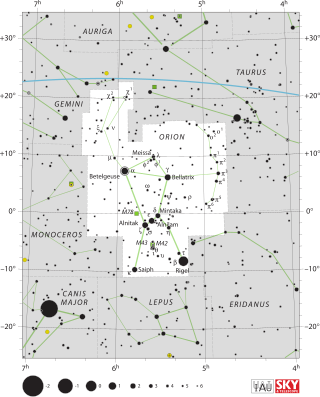
Orion is a constellation which is visible from most parts of the world. As well as being one of the 88 modern constellations, it was one of the 48 constellations listed by the 2nd-century astronomer Ptolemy. It is named for a hunter in Greek mythology.

The Orion Nebula is a diffuse nebula situated in the Milky Way, being south of Orion's Belt in the constellation of Orion,[b] and is known as the middle "star" in the "sword" of Orion. It is one of the brightest nebulae and is visible to the naked eye in the night sky with apparent magnitude 4.0. It is 1,344 ± 20 light-years (412.1 ± 6.1 pc) away and is the closest region of massive star formation to Earth. The M42 nebula is estimated to be 24 light-years across. It has a mass of about 2,000 times that of the Sun. Older texts frequently refer to the Orion Nebula as the Great Nebula in Orion or the Great Orion Nebula.
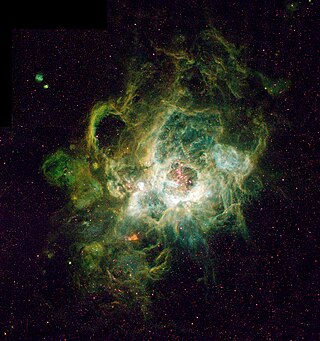
An H II region or HII region is a region of interstellar atomic hydrogen that is ionized. It is typically in a molecular cloud of partially ionized gas in which star formation has recently taken place, with a size ranging from one to hundreds of light years, and density from a few to about a million particles per cubic centimetre. The Orion Nebula, now known to be an H II region, was observed in 1610 by Nicolas-Claude Fabri de Peiresc by telescope, the first such object discovered.

The Trifid Nebula is an H II region in the north-west of Sagittarius in a star-forming region in the Milky Way's Scutum–Centaurus Arm. It was discovered by Charles Messier on June 5, 1764. Its name means 'three-lobe'. The object is an unusual combination of an open cluster of stars, an emission nebula, a reflection nebula, and a dark nebula. Viewed through a small telescope, the Trifid Nebula is a bright and peculiar object, and is thus a perennial favorite of amateur astronomers.

The Eagle Nebula is a young open cluster of stars in the constellation Serpens, discovered by Jean-Philippe de Cheseaux in 1745–46. Both the "Eagle" and the "Star Queen" refer to visual impressions of the dark silhouette near the center of the nebula, an area made famous as the "Pillars of Creation" imaged by the Hubble Space Telescope. The nebula contains several active star-forming gas and dust regions, including the aforementioned Pillars of Creation. The Eagle Nebula lies in the Sagittarius Arm of the Milky Way.
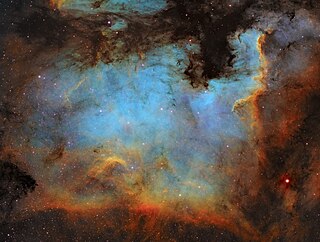
The North America Nebula is an emission nebula in the constellation Cygnus, close to Deneb. It is named because its shape resembles North America.

NGC 1999, also known as The Cosmic Keyhole, is a dust-filled bright nebula with a vast hole of empty space represented by a black patch of sky, as can be seen in the photograph. It is a reflection nebula, and shines from the light of the variable star V380 Orionis.
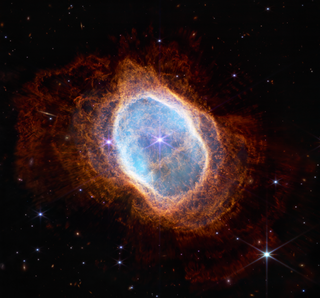
NGC 3132 is a bright and extensively studied planetary nebula in the constellation Vela. Its distance from Earth is estimated at about 613 pc or 2,000 light-years.

The Orion molecular cloud complex is a star-forming region with stellar ages ranging up to 12 Myr. Two giant molecular clouds are a part of it, Orion A and Orion B. The stars currently forming within the complex are located within these clouds. A number of other somewhat older stars no longer associated with the molecular gas are also part of the complex, most notably the Orion's Belt, as well as the dispersed population north of it. Near the head of Orion there is also a population of young stars that is centered on Meissa. The complex is between 1 000 and 1 400 light-years away, and hundreds of light-years across.

Sh2-279 is an HII region and bright nebulae that includes a reflection nebula located in the constellation Orion. It is the northernmost part of the asterism known as Orion's Sword, lying 0.6° north of the Orion Nebula. The reflection nebula embedded in Sh2-279 is popularly known as the Running Man Nebula.

NGC 6302 is a bipolar planetary nebula in the constellation Scorpius. The structure in the nebula is among the most complex ever seen in planetary nebulae. The spectrum of Butterfly Nebula shows that its central star is one of the hottest stars known, with a surface temperature in excess of 250,000 degrees Celsius, implying that the star from which it formed must have been very large.
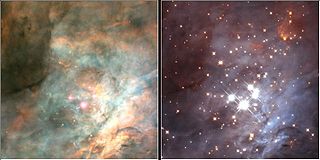
The Trapezium or Orion Trapezium Cluster, also known by its Bayer designation of Theta1 Orionis, is a tight open cluster of stars in the heart of the Orion Nebula, in the constellation of Orion. It was discovered by Galileo Galilei. On 4 February 1617 he sketched three of the stars, but missed the surrounding nebulosity. A fourth component (B) was identified by several observers in 1673, and several more components were discovered later like E, for a total of eight by 1888. Subsequently, several of the stars were determined to be binaries. Telescopes of amateur astronomers from about 5-inch (130 mm) aperture can resolve six stars under good seeing conditions.

The Flame Nebula, designated as NGC 2024 and Sh2-277, is an emission nebula in the constellation Orion. It is about 1350 light-years away. At that distance, the Flame Nebula lies within the Orion B cloud of the larger Orion Molecular Cloud Complex.
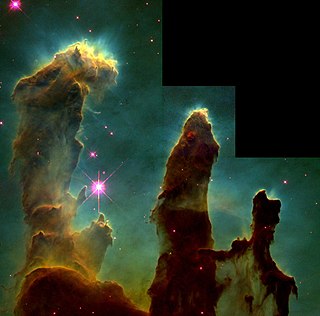
Pillars of Creation is a photograph taken by the Hubble Space Telescope of elephant trunks of interstellar gas and dust in the Eagle Nebula, in the Serpens constellation, some 6,500–7,000 light-years from Earth. These elephant trunks had been discovered by John Charles Duncan in 1920 on a plate made with the Mount Wilson Observatory 60-inch telescope. They are so named because the gas and dust are in the process of creating new stars, while also being eroded by the light from nearby stars that have recently formed.

NGC 2261 is a variable nebula located in the constellation Monoceros. The nebula is illuminated by the star R Monocerotis, which is not directly visible itself.

The Dark Doodad Nebula is a dark nebula near the globular cluster NGC 4372, much closer than the centre of the galaxy and in the galactic plane, having a length of nearly three degrees of arc. Although officially unnamed, this long molecular cloud has come to be known under this name. It can be found in the southern constellation of Musca with strong binoculars.

The Rho Ophiuchi cloud complex is a complex of interstellar clouds with different nebulae, particularly a dark nebula which is centered 1° south of the star ρ Ophiuchi, which it among others extends to, of the constellation Ophiuchus. At an estimated distance of about 140 parsecs, or 460 light years, it is one of the closest star-forming regions to the Solar System.

Rogelio Bernal Andreo is a Spanish-American astrophotographer. He is known for his photographs of deep sky objects. His work has been recognized by NASA as a regular contributor to their Astronomy Picture of the Day (APOD) 80 times. Andreo's photography has been published in international magazines and periodicals, as well as television networks including the BBC, National Geographic, and the Discovery Channel series Into the Universe with Stephen Hawking.




















